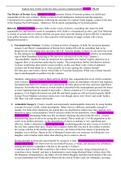Summary
Summary Plan: 'Explore how writers of the two texts you have studied present violence'
- Module
- Comparative Study
- Institution
- AQA
A detailed essay plan answering the question - 'Explore how writers of the two texts you have studied present violence'. Paragraphs consider foreshadowed violence, animalistic imagery, and aftermath setting, including key quotations from texts, techniques, and structural points.
[Show more]












